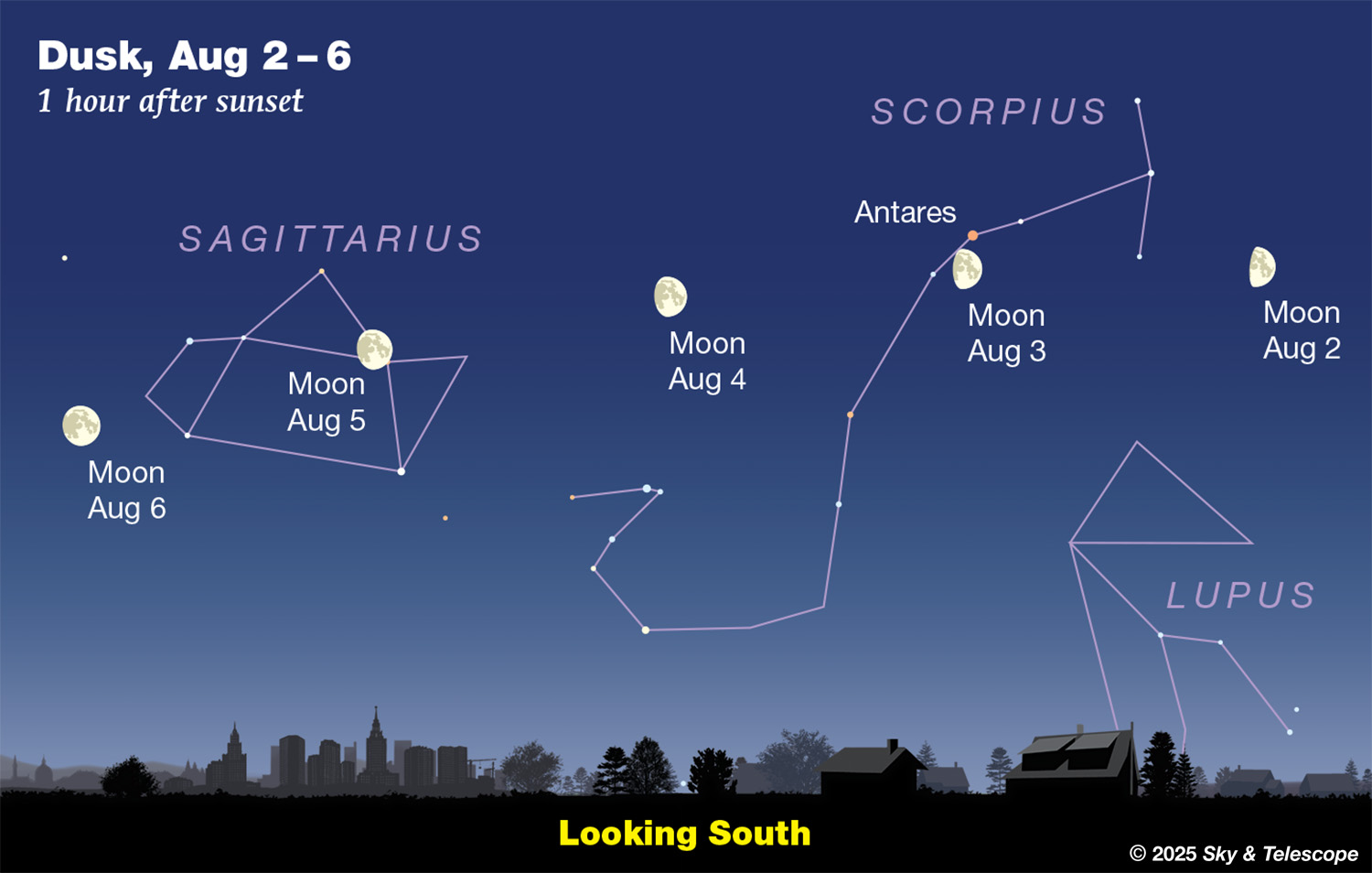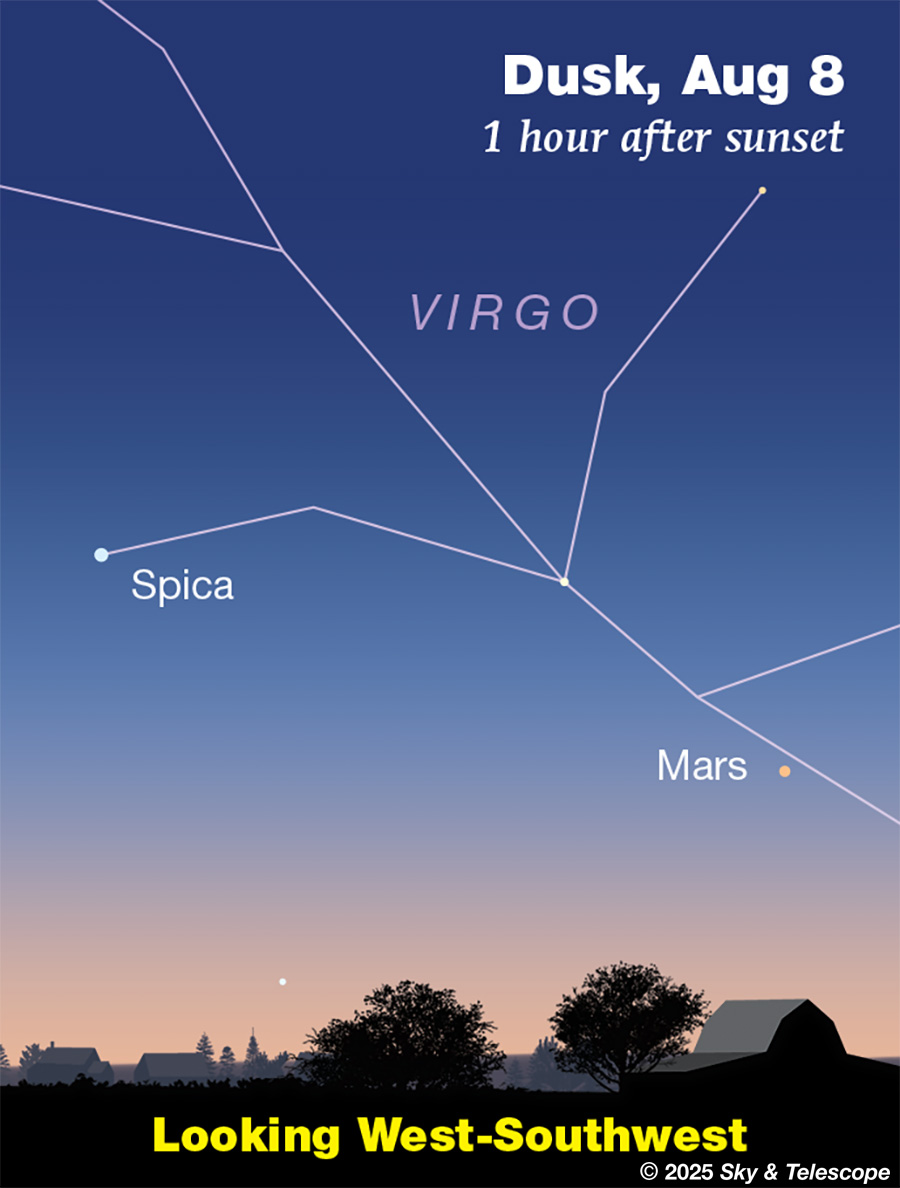FRIDAY, AUGUST 1
■ First-quarter Moon; exactly so at 8:41 a.m. EDT. The Moon, in Libra, hangs halfway between Antares two fists to its upper left and Spica sinking down two fists to its lower right.
SATURDAY, AUGUST 2
■ The long, drawn-out Delta Aquariid meteor shower continues, weakly. Its nominal peak was July 30th more or less, but the shower runs until mid-August, overlapping the Perseids — which this year will be washed by moonlight. See Bob King’s Thumbs Up for the Delta Aquariid Meteor Shower.
■ Titan casts its shadow on Saturn tonight. Every 15 years Titan, Saturn’s largest moon, repeatedly crosses Saturn’s face from Earth’s viewpoint — and, more visibly, casts its very tiny black shadow onto Saturn’ face. A new series of these events is under way. They will continue every 16 days until October.
Tonight Titan’s shadow crosses Saturn from 6:25 to 11:04 UT August 3rd (UT date). That’s from 2:25 to 7:04 a.m. August 3rd Eastern Daylight Time; or 11:25 p.m. Aug. 2nd to 4:04 a.m. Aug. 3rd PDT. Wherever you are, Saturn rises by 11 p.m. local daylight-saving time and is high in good seeing before dawn. So all of North America gets a chance at this shadow transit. See Bob King’s Titan Shadow Transit Season Underway.
But if you’re used to seeing shadows of Jupiter’s moons on Jupiter, be warned: Saturn is twice as far away, and although Titan is large, it’s not twice as large as any of Jupiter’s moons.

SUNDAY, AUGUST 3
■ This evening the waxing gibbous Moon hangs hardly more than 1° below orange Antares, the 1st-magnitude heart of Scorpius. “The neutral gray of the lunar surface always seems to enhance the color of whatever star or planet the Moon is near,” writes Gary Seronik in the August Sky & Telescope. Do you agree?
MONDAY AUGUST 4
■ Now the thickening, brightening gibbous Moon shines midway between Antares to its right and the spout of the Sagittarius Teapot to its left.
TUESDAY, AUGUST 5
■ This evening for North America, the Moon sits where the Teapot’s spout joins its body. To bring out the Teapot’s 2nd- and 3rd-magnitude stars, cover the Moon with a fingertip to hide its bright glare. Or better, use two fingertips, one for each eye. Close one eye and position a fingertip onto the Moon, then do the same for the other eye with another fingertip. Then without moving, open both eyes.
WEDNESDAY, AUGUST 6
■ Now the Moon is just left of the Teapot’s handle.
THURSDAY, AUGUST 7
■ Vega passes its closest to overhead around 10 or 11 p.m. now, depending on how far east or west you are in your time zone.
How closely Vega misses your zenith depends on how far north or south you are. It passes right through your zenith if you’re at latitude 39° north (Washington DC, Cincinnati, Kansas City, Lake Tahoe). How closely can you judge its verticality? It helps to lie on your back.
Deneb crosses closest to the zenith almost exactly two hours after Vega. But to see Deneb straight up you need to be farther north, close to latitude 45°: Portland, Minneapolis, Montreal, central Maine, southern France, northern Italy, Odesa, Kherson.
FRIDAY, AUGUST 8
■ Week after week now, distant little Mars stays practically on station at the same height low in the west-northwest in twilight. Its long apparition drags on and on: Mars will continue to set around the end of twilight into early fall (for observers at mid-northern latitudes), and it won’t reach conjunction with the Sun until the beginning of 2026.

SATURDAY, AUGUST 9
■ The two brightest stars of summer are Vega, overhead shortly after nightfall, and Arcturus, shining in the west. Draw a line down from Vega to Arcturus. A third of the way down, the line crosses the dim Keystone of Hercules. Two thirds of the way down it crosses the dim semicircle of Corona Borealis with its one modestly bright star, Alphecca or Gemma. If you’ve been watching for the supposed next explosion of T Coronae Borealis, it has now gone half of another summer unexploded.
■ Vega and the Keystone’s star closest to it form an equilateral triangle with 2nd-magnitude Eltanin to their north, the nose of Draco the Dragon. Eltanin is the brightest star of Draco’s quadrilateral head; he’s eyeing Vega.
SUNDAY, AUGUST 10
■ This is the time of year when the Big Dipper scoops down in the northwest during evening, as if to pick up the water that it will dump from high overhead in the evenings of next spring.
■ Are you seeing any early Perseid meteors yet? Despite the moonlight? The Perseids are active at noticeable levels for many days before and several days after their peak, which this year is predicted for the night of August 12-13.
This Week’s Planet Roundup
Mercury is hiding deep in the sunrise.
Venus, brilliant at magnitude –4.0, rises above the east-northeast horizon about an hour before the first sign of dawn, followed by Jupiter, the second brightest planet at magnitude –1.9. On Saturday morning August 2nd they rise about 40 minutes apart, but a week later on the 9th Jupiter follows 0nly about 10 minutes behind Venus. During this time their separation shrinks from 9° to 3°.
They’ll come to a spectacular close conjunction on the morning of August 12th, 0.9° apart, with Jupiter then to Venus’s upper left (north).
Mars, a weak magnitude 1.6 at the border of Leo and Virgo, still glimmers very low due west in twilight. Binoculars will help. Mars sets at twilight’s end.
Saturn (magnitude +0.8, in Pisces) rises around 10 p.m. daylight-saving time. But the best time to try a telescope on Saturn is in the hours before dawn, when it’s highest in the south. We see Saturn’s rings almost edge-on this year, and the Sun shines on them from nearly our direction too. So the rings and their shadow form a super-thin black line along Saturn’s equator.
Uranus (magnitude 5.8, in Taurus near the Pleiades) rises around midnight or 1 a.m. and is well placed in the east before the beginning of dawn. In a telescope it’s a tiny but definitely non-stellar blob 3.6 arcseconds wide.
Neptune, a telescopic “star” at magnitude 7.9, lurks 1° from Saturn in the early morning hours. Use the finder chart for Neptune with respect to Saturn in the June Sky & Telescope, page 51. With a pencil, put a dot on the path of each of the two planets for your date. Get everything planned and ready the evening before, so that dawn doesn’t overtake you before you find it!
All descriptions that relate to your horizon — including the words up, down, right, and left — are written for the world’s mid-northern latitudes. Descriptions and graphics that also depend on longitude (mainly Moon positions) are for North America. Eastern Daylight Time (EDT) is Universal Time minus 4 hours. UT is also known as UTC, GMT, or Z time.
Want to become a better astronomer? Learn your way around the constellations. They’re the key to locating everything fainter and deeper to hunt with binoculars or a telescope.
This is an outdoor nature hobby. For a more detailed constellation guide covering the whole evening sky, use the big monthly map in the center of each issue of Sky & Telescope, the essential magazine of astronomy.
For the attitude every amateur astronomer needs, read Jennifer Willis’s Modest Expectations Give Rise to Delight.
Once you get a telescope, to put it to good use you’ll need a much more detailed, large-scale sky atlas (set of charts). The basic standard is the Pocket Sky Atlas, in either the original or Jumbo Edition. Both show all 30,000 stars to magnitude 7.6, and 1,500 deep-sky targets — star clusters, nebulae, and galaxies — to search out among them.

Next up is the larger and deeper Sky Atlas 2000.0, plotting stars to magnitude 8.5; nearly three times as many, as well as many more deep-sky objects. It’s currently out of print, but maybe you can find one used.
The next up, once you know your way around well, are the even larger Interstellarum atlas (with 201,000+ stars to magnitude 9.5 and 14,000 deep-sky objects selected to be detectable by eye in large amateur telescopes), and Uranometria 2000.0 (332,000 stars to mag 9.75, and 10,300 deep-sky objects). And read How to Use a Star Chart with a Telescope. It applies just as much to charts on your phone or tablet (which many observers find more versatile) as to charts on paper.
You’ll also want a good deep-sky guidebook. A beloved old classic is the three-volume Burnham’s Celestial Handbook. An impressive more modern one is the big Night Sky Observer’s Guide set (2+ volumes) by Kepple and Sanner. The pinnacle for total astro-geeks is the new Annals of the Deep Sky series, currently at 11 volumes as it works its way forward through the constellations alphabetically. So far it’s up to H.
Can computerized telescopes replace charts? Not for beginners I don’t think, and not for scopes on mounts and tripods that are less than top-quality mechanically. Unless, that is, you prefer spending your time getting finicky technology to work rather than learning how to explore the sky. As Terence Dickinson and Alan Dyer say in their Backyard Astronomer’s Guide, “A full appreciation of the universe cannot come without developing the skills to find things in the sky and understanding how the sky works. This knowledge comes only by spending time under the stars with star maps in hand and a curious mind.” Without these, “the sky never becomes a friendly place.”
If you do get a computerized scope, make sure that its drives can be disengaged so you can swing it around and point it readily by hand when you want to, rather than only slowly by the electric motors (which eat batteries).
However, finding faint telescopic objects the old-fashioned way with charts isn’t simple either. Do learn the essential tricks at How to Use a Star Chart with a Telescope.
![]() Audio sky tour. Out under the evening sky with your
Audio sky tour. Out under the evening sky with your
earbuds in place, listen to Kelly Beatty’s monthly
podcast tour of the naked-eye heavens above. It’s free.
“The dangers of not thinking clearly are much greater now than ever before. It’s not that there’s something new in our way of thinking, it’s that credulous and confused thinking can be much more lethal in ways it was never before.”
— Carl Sagan, 1996
“Facts are stubborn things; and whatever may be our wishes, our inclinations, or the dictates of our passion, they cannot alter the state of facts and evidence.”
— John Adams, 1770

